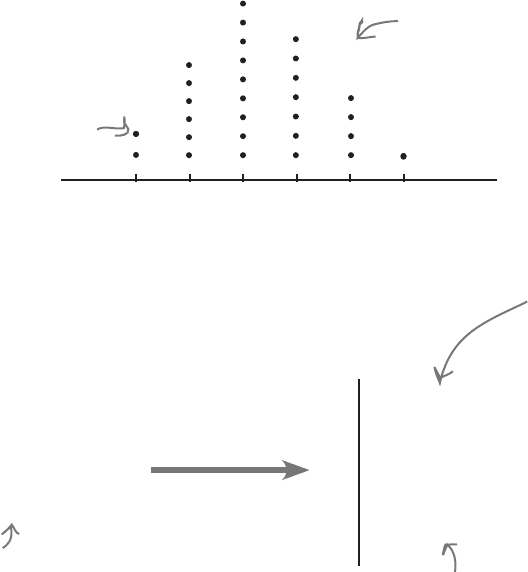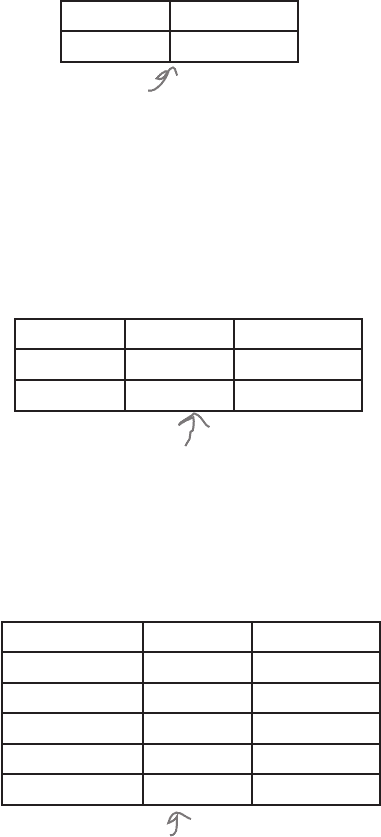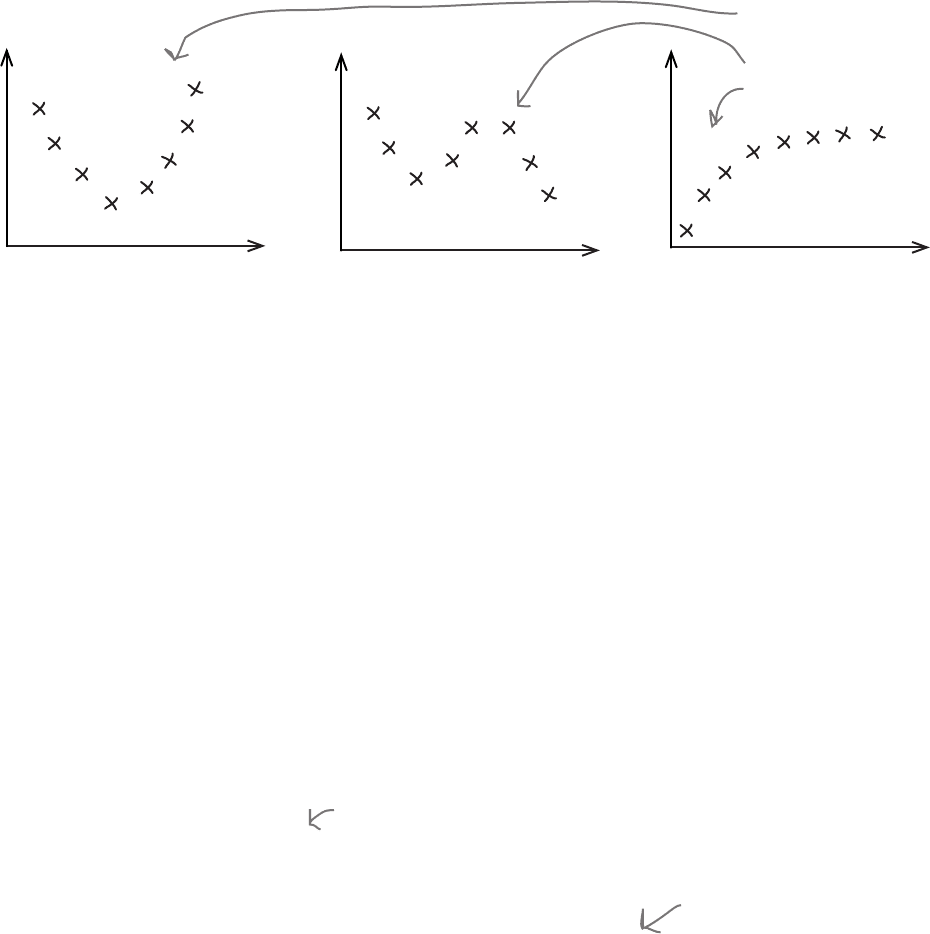Griffiths D. Head First Statistics
Подождите немного. Документ загружается.


you are here 4 641
correlation and regression
Leaving town...
It’s been great having you here in Statsville!
We’re sad to see you leave, but there’s nothing like taking what you’ve learned
and putting it to use. There are still a few more gems for you in the back of the book,
some handy probability tables, and an index to read though, and then it’s time to take all
these new ideas and put them into practice. We’re dying to hear how things go, so drop
us a line at the Head First Labs web site, www.headfirstlabs.com, and let us know how
Statistics is paying off for YOU!

this is an appendix 643
appendix i: leftovers
The Top Ten Things
(we didn’t cover)
Even after all that, there’s still a bit more.
There are just a few more things we think you need to know. We wouldn’t feel right about
ignoring them, even though they only need a brief mention, and we really wanted to
give you a book you’d be able to lift without extensive training at the local gym. So before
you put the book down, take a read through these tidbits.
Even after all that, there’s still a bit more.
There are just a few more things we think you need to know. We wouldn’t feel right about
ignoring them, even though they only need a brief mention, and we really wanted to
give you a book you’d be able to lift without extensive training at the local gym. So before
you put the book down, take a read through these tidbits.
Oh my, look at
what’s left...

644 Appendix i
dotplots and stemplots
#1. Other ways of presenting data
We showed you a number of charts in the first chapter, but here are a
couple more that might come in useful.
If your data’s quantitive, dotplots
show you the shape of your data.
Stemplots
A stemplot is used for quantitive data, usually when your data set is fairly
small. Stemplots show each exact value in your data set in such a way that
you can easily see the shape of your data. Here’s an example:
Each value is shown as a dot. You
stack them in a column above the
value on the horizontal axis.
The entries on the left are called stems, and the entries on the right are
called leaves. In this stemplot, the stem shows tens, and the leaves show
units. To find each value in the raw data, you take each leaf and add it to its
stem. As an example, take the line
10 | 6 7
This represents two numbers, 16 and 17. You get 16 by adding the leaf 6 to
its stem 10. Similarly, you get value 17 by adding the leaf 7 to the stem 10.
There’s usually a key to help you interpret the stemplot correctly. In this case,
the key is 10 | 6 = 16.
Dotplots
A dotplot shows your data on a chart by representing each value as a dot.
You put each dot in a stacked column above the corresponding value on
the horizontal axis like this:
0 1 2 3 4 5
No. games bought per month
16 17 22 23 23 24 25 26 26 27 28
29 29 30 31 31 32 32 33 34 34 35
36 37 37 38 39 40 41 42 42 43 43
44 45 45 49 50 50 50 51 55 58 60
60 0
50 0 0 0 1 5 8
40 0 1 2 2 3 3 4 5 5 9
30 0 1 1 2 2 3 4 4 5 6 7 7 8 9
20 2 3 3 4 5 6 6 7 8 9 9
10 6 7
Key: 10 | 6 = 16
Here’s your raw data.
Here’s a stemplot
based on the data.
A stemplot has a shape that is similar to a
histogram’s, but flipped onto its side.

you are here 4 645
leftovers
#2. Distribution anatomy
There are two rules that tell you where most of your data values lie in a
probability distribution.
Chebychev’s rule isn’t as precise as the empirical rule, as it only gives you the
minimum percentages, but it still gives you a rough idea of where values fall in the
probability distribution. The advantage of Chebyshev’s rule is that it applies to any
distribution, while the empirical rule just applies to the normal distribution.
The empirical rule for normal distributions
The empirical rule applies to any set of data that follows a normal
distribution. It states that almost all of the values lie within three standard
deviations of the mean. In particular,
Chebyshev’s rule for any distribution
A similar rule applies to any set of data called Chebyshev’s rule, or
Chebyshev’s inequality. It states that for any distribution
Just knowing the number of standard deviations from the mean can
give you a rough idea about the probability.
At least 75% of your values lie within 2 standard deviations of the mean.
At least 89% of your values lie within 3 standard deviations of the mean.
At least 94% of your values lie within 4 standard deviations of the mean.
About 68% of your values lie within 1
standard deviation of the mean.
About 95% of your values lie within 2
standard deviations of the mean.
About 99.7% of your values lie within 3
standard deviations of the mean.
μ σ 2σ 3σ-σ-2σ-3σ
68%
99.7%
95%
The empirical rule tells you what percentage
of your values you can expect to lie in
which area of a normal distribution.

646 Appendix i
#3. Experiments
Experiments are used to test cause and effect relationships between variables. As an
example, an experiment could test the effect of different doses of SnoreCull on snorers.
In an experiment, indpendent variables or factors are manipulated so that we can
see the effect on dependent variables. As an example, we might want to examine the
effect that different doses of SnoreCull have on the number of hours spent snoring in a
night. The doses of SnoreCull would be the independent variable, and the number of
hours spent snoring would be the dependent variable.
The subjects that you use for your experiment are called experimental units—in this
case, snorers.
So what makes for a good experiment?
There are three basic principles you need to bear in mind when you design an
experiment: controls, randomization, and replication. Just as with sampling, a
key aim is to minimize bias.
You need to control the effects of external influences or natural variability.
When you conduct an experiment, you need to minimize effects that are not part of the
experiment. To do this, the first thing is to have a control group, a neutral group that receives
no treatments, or only neutral treatments. You can assess the effectiveness of the treatment by
comparing the results of your treated groups with the results of your control group.
A placebo is a neutral treatment, one that has no effect on the dependent variable. Sometimes
the subjects of your experiment can respond differently to having a neutral treatment as opposed
to having no treatment at all, so giving a placebo to a group is a way of controlling this effect. If
the group taking a placebo doesn’t know that it’s a placebo, then this is called blinding, and it’s
called double blinding if even those administering the treatments don’t know.
You need to assign subjects to treatments at random.
You’ll see more about this on the next page.
You need to replicate treatments.
Each treatment should be given to many subjects. You need to use many snorers per treatment to
gauge the effects, not just one snorer.
Another factor to be aware of is confounding. Confounding occurs when the
controls in an experiment don’t eliminate other possible causes for the effect on the
dependent variable. As an example, imagine if you gave doses to SnoreCull to men,
but placebos to women. If you compared the results of the two groups, you wouldn’t
be able to tell whether the effect on the men was because of the drug, or because one
gender naturally snores more than another.
conducting experiments

you are here 4 647
leftovers
Designing your experiment
We said earlier that you need to randomly assign subjects to experiments. But what’s
the best way of doing this?
Completely randomized design
One option is to use a completely randomized design. For
this, you literally assign treatments to subjects at random. If
we were to conduct an experiment testing the effect of doses
of SnoreCull on snorers, we would randomly assign snorers to
particular treatment groups. As an example, we could give half
of the snorers a placebo and the other half a single dose of
SnoreCull.
Completely randomized design is similar to simple random
sampling. Instead of choosing a sample at random, you assign
treatments at random.
Randomized block design
Another option is to use randomized block design. For
this, you divide the subjects into similar groups, or blocks.
As an example, you could split the snorers into males and
females. Within each block, you assign treatments at random,
so for each gender, you could give half the snorers a dose of
SnoreCull and give the other half a placebo. The aim of this
is to minimize confounding, as it reduces the effect of gender.
Randomized block design is similar to stratified random
sampling. Instead of splitting your population into strata, you
split your subjects into blocks.
Matched pairs design
Matched pairs design is a special case of randomized
block design. You can use it when there are only two
treatment conditions and subjects can be grouped into like
pairs. As an example, the SnoreCull experiment could have
two treatment conditions, to give a placebo or to give a
single dose, and snorers could be grouped into similar pairs
according to gender and age. You then give one of each
pair a placebo, and the other a dose of SnoreCull. If one
pair consisted of two men aged 30, for instance, you would
give one of the men a placebo and the other man a dose of
SnoreCull.
Placebo SnoreCull
500 500
If there were 1,000 subjects, we
could give half a placebo and the
other half a dose of SnoreCull
Placebo SnoreCull
Male
250 250
Female
250 250
If there were 500 men and 500
women, we could give half of each
gender a placebo and the other
half a dose of SnoreCull
Placebo SnoreCull
Male 30
1 1
Male 30
1 1
Female 30
1 1
Female 30
1 1
...
... ...
You could also form matched pairs using
gender and age to negate confounding due to
these variables.

648 Appendix i
In Chapter 15 you saw how a least squares regression line takes the
form y = a + bx, where
b = Σ(x - x)(y - y)
Σ(x - x)
2
There’s another form of writing this that a lot of people find easier to
remember, and that’s to rewrite it in terms of variances. If we use the
notation
then you can rewrite the formula for the slope of a line as
You can do something similar with the correlation coefficient. Instead of writing
r = b s
x
s
y
you can write the equation for the correlation coefficient as
s
xy
is called the covariance. Just as the variance of x describes how the x values
vary, and the variance of y describes how the y values vary, the covariance of x
and y is a measure of how x and y vary together.
s
x
2
= Σ(x - x)
2
s
y
2
= Σ(y - y)
2
s
xy
= Σ(x - x)(y - y)
n - 1 n - 1 n - 1
b = s
xy
s
x
2
r = s
xy
s
x
s
y
This is the formula for
the slope of the line.
This is the formula
for the correlation
coefficient.
This is the same
calculation written in a
different way.
x
y
a
b
y = a + bx
#4. Least square regression alternate notation
Sample variance
of the x values
Sample variance
of the y values
other formulas for least square regression

you are here 4 649
leftovers
#5. The coefficient of determination
The coefficient of determination is given by r
2
or R
2
. It’s the percentage
of variation in the y variable that’s explainable by the x variable. As an
example, you can use it to say what percentage of the variation in open-air
concert attendance is explainable by the number of hours of predicted
sunshine.
If r
2
= 0, then this means that you can’t predict the y value from the x value.
If r
2
= 1, then you can predict the y value from the x value without any errors.
Usually r
2
is between these two extremes. The closer the value of r
2
is to 1,
the more predictable the value of y is from x, and the closer to r
2
it is, the less
predictable the value of y is.
Calculating r
2
There are two ways of calculating r
2
. The first way is to just square the
correlation coefficient r.
Another way of calculating it is to add together the squared distances of the
y values to their estimates, and then divide by the result of adding together
squared distances of the y values to y.
r
2
=
(
s
xy
)
2
s
x
s
y
r
2
= Σ(y - y)
2
Σ(y - y)
2
^
This gives you the same value as
above; it’s just a different way of
calculating it..
This is just the correlation
coefficient squared.
sunshine (hours)
attendance (100’s)
0 1 2 3 4 5 6 7 8
0
10
20
30
40
50
60
x
y
r
2
tells you what percentage of the
variation in concert attendance is
explainable by the number of hours
predicted sunshine.

650 Appendix i
non-linear relationships of two variables
#6. Non-linear relationships
If two variables are related, their relationship isn’t necessarily linear. Here are
some examples of scatter plots where there’s a clear mathematical relationship
between x and y, but it’s non-linear:
Linear regression assumes that the relationship between two variables can be
described by a straight line, so performing least squares regression on raw data
like this won’t give you a good estimate for the equation of the line.
There is a way around this, however. You can sometimes transform x and y in
such a way that the transformation is close to being linear. You can then perform
linear regression on the transformation to find the values of a and b. The big trick
is to try and transform your non-linear equation of the line so that it takes the
form
y' = a + bx'
where y' and x' are functions of x.
As an example, you might find that your line of best fit takes the form
y = 1/(a + bx)
This can be rewritten as
1/y = a + bx
so that y' = 1/y. In other words, you can perform least squares regression using
the line y' = a + bx, where y' = 1/y. Once you’ve transformed your y values, you
can use least squares regression to find the values of a and b, then substitute these
back into your original equation.
y
x
y
y
x
x
It’s now in the form y
ı
= a + bx,
so we can use linear regression.
If your line of
best fit isn’t
linear, you
can sometimes
transform it to
a linear form.
This is just a quick overview,
so you know what’s possible.
These all show definite
patterns, but they’re
not straight lines, so
they’re not linear.
